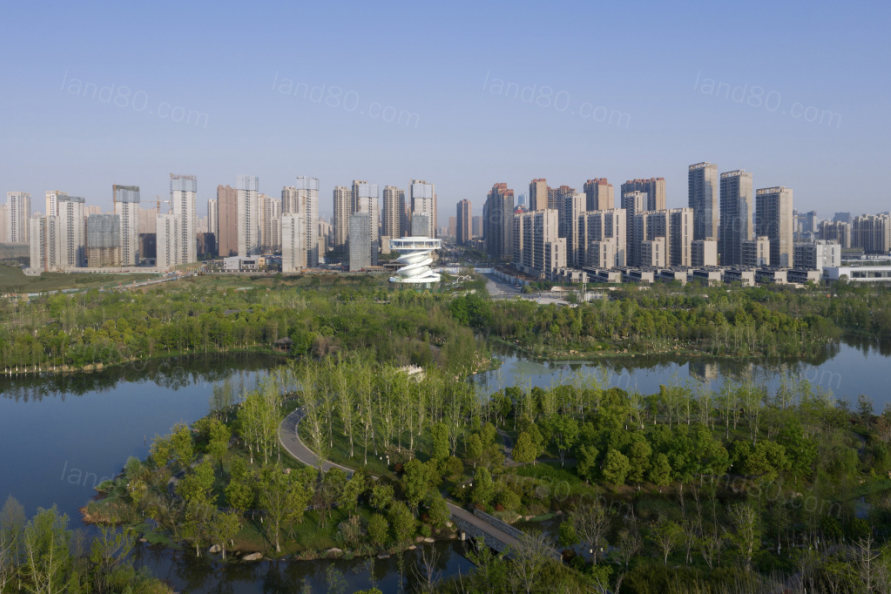 组图打开中,请稍候......
景观建筑建筑设计规划案例—本设计项目坐落于具有南昌自然景观建筑代表意义的象湖湿地公园景观设计旁。象湖湿地公园景观设计为设计项目提供了一个优质的自然plan基底,整体设计的灵感也起源于这些自然品质。建筑设计的设计建筑景观规划设计不仅仅是将湿地看做周边的“景色”,还希望将其自然的特质真实引入到设计项目中,营造建筑设计与景观建筑交融的设计空间体验。设计包含三种自然设计元素,水、大地与天空,分别对应前广场、商业配套与观景塔三个设计功能区。
Nordic Office of Architecture:The project is located next to the Elephant Lake Wetland Park, which is representative of the natural landscape of Nanchang. The Elephant Lake Wetland Park provides a quality natural site base for the project and the overall design was inspired by these natural qualities. The design concept of the architecture is not only to see the wetland as a “view” of the surrounding area, but also to bring its natural qualities into the project, creating a spatial experience where the building and the landscape blending together. The design consists of three natural elements, water, earth and sky, corresponding to three functional areas: the front square, the commercial facilities and the observation tower.

© Schran Image
前广场的景观建筑设计融入南昌亘古水历史人文及象湖景观建筑资源,因水而筑,以园林景观建筑规划设计象而名,构筑“水之万象”。以园林景观建筑规划设计马远十二水图成画,建构水之十二表情。每个景观建筑节点承载不同年龄参与者群的设计功能需求,带来令参与者难忘与充满趣味的设计空间体验。
The landscape design of the front square is integrated with the ancient water culture of Nanchang and the landscape resources of the Elephant Lake, which is built for the water and named after the Xiang (“view ”in Chinese) , constructing the “View of Water”. The water painting of Ma Yuan is painted to construct the twelve expressions of water. Each landscape node carries the functional needs of people of different ages, bringing a memorable and interesting space experience.

© Schran Image
▼设计功能分区图 Function diagram

© Nordic Office of Architecture

© Schran Image
建筑设计主体通过绵延的曲线波浪语言形成景观建筑设计元素在三维设计空间的延续。前广场的景观建筑体验通过一个徐徐展开的户外剧场延展到建筑设计的三维设计空间之上。同样,在建筑设计体量的两端市民也能够拾阶而上,来到为市民打造的屋顶花园。屋顶设计空间之下是散落布置的零售商业设计功能,通过外摆等方式与前广场丰富的户外活动设计空间联动起来,为设计项目周边的社区带来活力。
The main body of the building forms a continuation of the landscape elements in three dimensions through the language of stretched curves and waves. The landscape experience of the front square extends above the three-dimensional space of the architecture through a slowly unfolding outdoor amphitheatre. Likewise, citizens at both ends of the building can walk along the steps to the rooftop garden created for them. Underneath the rooftop space are scattered retail and commercial functions, which are linked to the rich outdoor activity space in the front plaza by means of external layout and so on, bringing vitality to the community around the project.

© Schran Image

© Schran Image
在朝向象湖湿地公园景观设计的端头,矗立着设计项目的最大亮点:一座代表未来生活蓝图与城市规划设计新精神的观景塔。南昌素来有“造塔”的历史传统,如江南三大名楼之一的滕王阁、历经千载的绳金塔等,站在设计项目所处的位置,便能远眺湿地公园景观设计内的万寿塔……鸟屿浮云塔的设计回应了这一本地历史人文,成为了代表南昌现代生活的新地标。
At the end of the park facing Elephant Lake Wetlands stands the project’s biggest highlight: a viewing tower that represents the blueprint for future living and the new spirit of the city. Nanchang has a long tradition of “towers”, such as the Teng Wang Pavilion, one of the three most famous buildings in Jiangnan, and the Shenjin Pagoda, which has lasted for thousands of years, etc. From the location of the project, you can see the Wanshou Pagoda in the wetland park from afar… The design of the viewing tower responds to this local culture and has become a new landmark representing modern life in Nanchang.


© Schran Image
© Schran Image

© Schran Image
双螺旋楼梯的形式为参与者们提供了一种新奇的观景体验:上与下的体验不再是一种重复,与观景结合,原本单调的“爬楼机械运动”被转换成了积极有趣的公共空间设计功能。顶部的观景台将这种趣味性和公共空间性提升到了顶峰,参与者们在这里可以俯瞰近处的湿地自然景观建筑,欣赏远处的城市规划设计天际线,体验日出日落的风景变幻。
The form of the double spiral staircase provides a novel viewing experience: the experience of going up and down is no longer a repetition, and in combination with the viewing, the monotonous “mechanical movement of climbing the stairs” is transformed into an active and interesting public function. This fun and communal nature of the tower is elevated to the peak by the observation deck at the top, where people can look down on the natural landscape of the nearby wetlands, admire the city skyline in the distance, and experience the changing landscape at sunrise and sunset.
© Schran Image

设计项目信息
设计项目名称: 华侨城·万科 世纪水岸鸟屿浮云
建筑设计事务所: Nordic Office of Architecture
网址: nordicarch.com
联络邮箱: yz@nordicarch.com
设计公司所在地: 挪威奥斯陆
设计项目完成年份: 2020
建筑设计规划面积: 5844.8.0㎡
设计项目地址: 我国江西省南昌市西湖区云锦路与真君路交叉口
主创建筑设计师: Thomas Lindgård Fagernes
主创建筑设计师邮箱: tf@nordicarch.com
媒体信息
摄影: ©是然建筑设计摄影
摄影师邮箱: schranimage@126.com
设计项目参与方
主创建筑设计师: Thomas Lindgård Fagernes
设计Team: 张扬、Diana Cruz、Pedro Joel Costa、Lucia Borg、Valentina Glavica
委托方: 江西万科(朱澍、万罗斌、周清华、李嘉磊、章登春、常雨萌、李慧乐)
顾问方:万科上海区域万晟科城(齐威、蒋紫琪)
景观建筑设计:朱育帆设计工作室(朱育帆、姚玉君、马珂、邱柏玮、张博雅、刘赟硕、张宁、曹天昊、杨宇欣、刘思、程飘、贾明睿)
照明设计:上海PINKO品光照明设计顾问
标识设计:LINKSWORKZ DESIGN STUDIO
建筑设计施工图设计:上海对外建设建筑设计设计有限设计公司
景观建筑施工图设计:上海栖地景观建筑规划设计有限设计公司
结构顾问:Rambøll
工程总承包:中天建设集团有限设计公司
景观建筑施工:杭州天勤景观建筑工程有限设计公司
雕塑施工:上海灏烁生态环境艺术有限设计公司
GRC施工:南京倍立达新材料系统工程股份有限设计公司
|